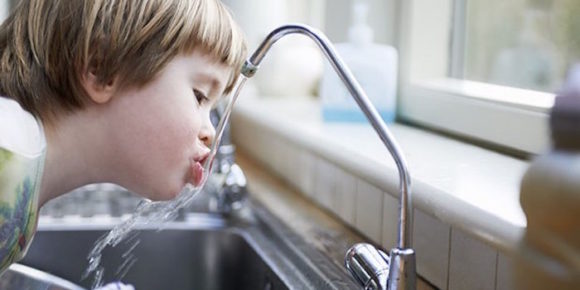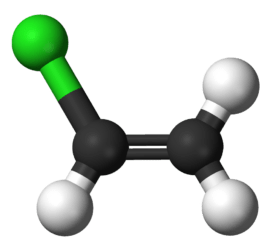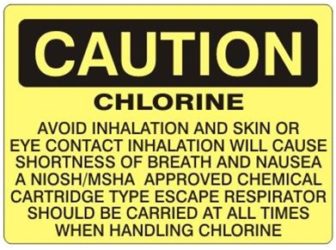
Drinking chlorine, is it safe?
There was a time when the only opportunity to smell that odour we equate with cleanliness, chlorine, was from a trip to the swimming baths.
Today, all processed vegetation is soaked in chlorinated water.
We only need turn on the tap and that smell of the swimming baths comes flooding out of the kitchen tap, with the odd wiff of what appears to be stagnant water straight out of some darkened swamp. I have often wondered, is the chlorine camouflaging the fact, what looks clear and wet flowing from my kitchen tap is in fact sewage water coming back to me from the expanding closed water systems being implemented by all utility companies?
With that in mind we need to take a look at the chemical chlorine and its affects on biological entities and the environment.
Halides are chemical substances such as Fluoride, Chlorine and Bromide, each having similar effects on the pineal gland.
Discovered in 1774 by Carl Wilhelm Scheele, who mistakenly thought it contained oxygen. Chlorine was given its name in 1810 by Humphrey Davy, who insisted that it was in fact an element.
The pure chemical element has the physical form of a diatomic green gas. The name chlorine is derived from chloros, meaning green, referring to the colour of the gas. Chlorine gas is two and one half times as heavy as air, has an intensely disagreeable suffocating odour, and is exceedingly poisonous. In its liquid and solid form it is a powerful oxidising, bleaching, and disinfecting agent.
Chlorine is a highly reactive gas. It is a naturally occurring element. The largest users of chlorine are companies that make ethylene dichloride and other chlorinated solvents, polyvinyl chloride (PVC) resins, chlorofluorocarbons, and propylene oxide. Paper companies use chlorine to bleach paper.
Water and waste-water treatment plants use chlorine to reduce water levels of micro-organisms (disinfection).
Exposure to chlorine can occur in the workplace or in the environment following releases to air, water, or land.
People who use laundry bleach and swimming pool chemicals containing chlorine products are usually not exposed to chlorine itself. Chlorine is generally found only in industrial settings.
Chlorine enters the body breathed in with contaminated air or when consumed with contaminated food or water.
Effects of chlorine on human health depend on how the amount of chlorine that is present, and the length and frequency of exposure. Effects also depend on the health of a person or condition of the environment when exposure occurs.
Breathing small amounts of chlorine for short periods of time adversely affects the human respiratory system. Effects differ from coughing and chest pain, to water retention in the lungs. Chlorine irritates the skin, the eyes, and the respiratory system. These effects are not likely to occur at levels of chlorine that are normally found in the environment.
Environmental effects of chlorine
Chlorine dissolves when mixed with water. It can also escape from water and enter air under certain conditions. Most direct releases of chlorine to the environment are to air and to surface water.
Once in air or in water, chlorine reacts with other chemicals. It combines with inorganic material in water to form chloride salts, and with organic material in water to form chlorinated organic chemicals.
Because of its reactivity chlorine is not likely to move through the ground and enter groundwater.
Plants and animals are not likely to store chlorine. However, laboratory studies show that repeat exposure to chlorine in air can affect the immune system, the blood, the heart, and the respiratory system of animals.
Chlorine causes environmental harm at low levels. Chlorine is especially harmful to organisms living in water and in soil.
Effects of Chlorine in drinking water
Moderate to heavy consumption of chlorinated tap water by pregnant women has been linked with miscarriage, birth defects, heart problems, cleft palate, and major brain defects.[a]
The presence of chlorine in tap water has been linked to the dramatic rise of heart disease in the United States. Scientists argue that chlorine is a primary cause of the development of atherosclerosis, or hardening of the arteries.[b]
Studies show chlorinated water is toxic to human intestinal bacteria, the body’s natural flora that converts organic compounds in our food into necessary nutrients.[b]
The American Journal of Epidemiology contains one of a number of studies that report chlorine disinfection by-products (DBPs) are responsible for the increase in rectal and bladder cancers.[b]
Several research journals, including Environmental Health Perspectives, call the chlorine disinfectant by-product Mutagen X (or MX) one of the most deadly carcinogens in tap water.[b]
After large rainstorms, your municipal water centre may add more chlorine to the water supply to treat potentially larger number of micro-organisms due to runoff or sewage discharges.[d]
During the summer, surface water used for drinking contains more organic material and, as a result, DBP levels are often higher than they are in the fall and other times of the years.[d]
Chlorinated water increases the amount of heavy metals such as lead and copper that are leached from pipes into tap water.[b]
Because chlorine is a calcium antagonist, long-term consumption of chlorinated water has been linked to loss of calcium in bones. Chlorinated tap water has also been linked to childhood and adult asthma and allergies.[b]
The EPA allows a higher level of chlorine in tap water (4 parts per million/ppm) than the recommended chlorine levels for public swimming pools (1-3 ppm).[c]
THM & MX Cocktail
Some of nature’s most valuable and essential anti-cancer and anti-disease phytochemical nutrients, which are commonly found in food, have been discovered to form deadly cancer causing substances when consumed or combined with chlorinated tap water. This discovery includes familiar foods including soy, fruits, vegetables, tea, many health products, and some prescriptions.
Recently, a joint study was undertaken in Japan by research scientists at the National Institute of Health Sciences and Shizuoka Prefectural University. They determined that natural organic substances react when exposed to chlorinated tap water, forming dangerous cancer causing compounds named MX, which stands for “Unknown Mutagen”. They are similar to the already well-known and more easily detected cancer causing THMs (trihalomethanes).
Earlier studies by scientists in Finland in 1997 determined that MX is 170 times more deadly than other known toxic by-products of chlorination, and was shown in laboratory studies to damage the thyroid gland as well as cause cancerous tumors.
There is nothing wrong with the organic substances themselves. It is chlorine that is at fault for turning them into the deadly THM and MX cancer cocktail. The reality is that the organic substances have been shown to be highly beneficial combined with pure drinking water.
It is certain that the fresh plant foods we eat similarly react with the chlorinated tap water we drink with our meals, creating toxins. This means that fresh fruits and vegetables, green salads, green tea, black tea, herb teas, soy products, vitamins and various health supplements, and even some pharmaceutical drugs all can be implicated in combination with chlorinated water.
The dangerous cancer causing agents which are produced are extremely toxic in infinitesimal amounts so small and obscure that they are very difficult to detect. Very little chlorine is required. Full Story
Notes
[a] “Drinking Tap Water Disinfected with Chlorine May Harm Fetus, Study Suggests.” Science Daily. June 5, 2008. Accessed: June 4, 2010.
[b] Kahuna Kupua A’o, Lono. 2004. Don’t Drink the Water. Twin Lakes, WI: Lotus Press.
[c] “Pool Water Chemistry.” Pool and Spa. Accessed: June 7, 2010.
[d] “Questions and Answers on Health Effects of Disinfection Byproducts.” U.S. Environmental Protection Agency. Accessed: June 6, 2010.
Further Study
Dangers of Chlorinated Water
Chlorine – A Special Problem for Drinking Water
Chlorine and Saltwater facts
Finnish Study Links Chlorinated Water to Cancer
Sodium Chloride Tree
United Utilities Cryptosporidium, Secrecy, Androgens and a Resigned MP
Mental Health, Transgenderism and Endocrine Disruptors
Water

